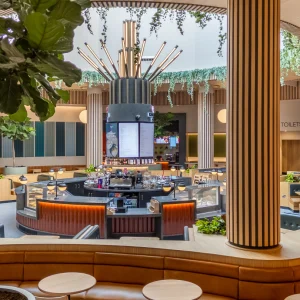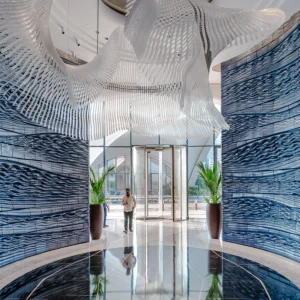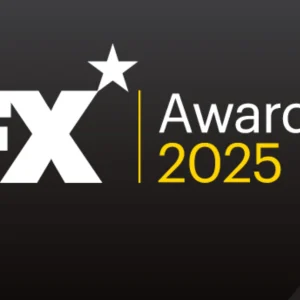
Exetera's new pop-up temporary showroom focuses on its new range of 3D printers – called Earth, Wind and Fire – with the space constructed by the materials that fuel each printer's purpose. The visitor is carried through the space on a journey of textures and materials celebrating the product.
Between the three distinct product zones the flooring scheme weaves together the journey for the visitor experiencing the origin of the materials in raw form. The journey begins with a small reception and welcome area. From here the visitor is drawn towards the coloured main circulation loop composed of a pixelated blend of Bolon linear strips.

Each colour represents one of the three materials associated with each printer and acts as a way finding tool to guide visitors through the space. The colours blend together as the visitor approaches the next printer, stitching the journey together.
Rich terracotta-coloured ceramic tile represents the raw earth where the material was born, a Plexiglass plinth fi lled with an undulating metal mesh are reflective of the movement, rhythm and transparency of wind, and polished stainless steel represents the liquid metal in its original state
Each printer sits on a raised material-clad plinth that unfolds to create platforms within the zones where one can experience and learn about the products. Becoming the focus within the space, the machines are elevated as if they were part of an exhibit in a museum. A black Bolon background creates a strong unifying base, allowing the fl ashes of colour and materials to shine through. Each printer is complemented by a plywood board telling the Exetera story and explaining the printing process.

In the design by Marta Nowicka & Co, the showroom's flooring structure, which defines the three printers' presence, rises from the central area
The scheme revolves around a central hub designed to encourage discussion of ideas and appreciation of the products. Simple plywood furniture is used throughout the showroom to complement the storyboards and again contrast the black backdrop of the floor.
Applied vinyl wall graphics enhance the story within the delineated zones, with the materiality reflecting the temporary practical nature of the pop-up exhibition space.
Materials used for flooring:
– Bolon Woven Vinyl Floor Tiles
– Now, Silver
– BKB, Sisal Plain White
– BKB, Sisal Plain Black
– Artisan, Clay
– Grestec Ceramic Tile
– Bell Collection, ELE8684, 75mm x 150mm
– Plexiglass with Aluminium Modelling Wire Mesh
– Polished Stainless Steel
With thanks to Natasha Bonugli, Phoebe Settle, Greta Kriovaite and Fabrizio Cazzulo from Woods Bagot.

The flooring concept delineates three different printing processes employed by Exetera, through the application of simple zone division, and exposes each of the printers within its own designated space by the design of the flooring structure. Apart from spatial articulation, this also provides the possibility of visitors to the showroom watching the printing process.
The flooring structure, which defines the printers, rises from the central area – the reception / meeting space – and creates a slope throughout the whole showroom. The slope meets the inner walls of the space and continues upwards on its surface until the ceiling line. The flooring structure is divided into three distinguishable areas with each printer assigned to its zone, which corresponds by the materiality to the function of the printer: FIRE – the printer which cuts in metals – is surrounded by a metal cladded slope; EARTH – the ceramic printer – is placed in the terracotta-cladded zone and WIND – a very fast printer – sits within in the mirror-clad area. This design scheme emphasises the unique qualities of each of the machines and translates them into an architectural experience.
All questions can be answered and information provided regarding the printing process, or the finished product, by friendly personnel in the centre of the room accommodating the reception / welcome area. Moreover, the centralisation of this zone focuses the attention on the three different printing areas, which are spread around the space.
The material diversity of the flooring structure, which continues as screen wall panels, informs the visitors about the three different types of 3D printing provided by Exetera. The printing process itself is a spectacle to be watched by the visitors, who can gather around the printer of their choice to become familiarised with all the phases of 3D printing – the flooring structure becomes a sitting zone as well as a spatial definition.
The powerful simplicity of the design visible through the showroom's windows impacts the passers-by and invites them to discover Exetera.
Thanks to Marta Norwicka & Co
www.domstay.com





